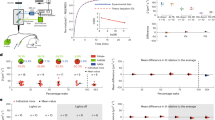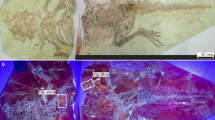Abstract
Deep litter has been shown to decrease stereotypic wire-gnawing in male golden hamsters, suggesting that increased litter depth may be associated with decreased chronic stress levels. To determine the relationship between litter depth and stress levels in hamsters, the authors measured serum levels of corticosterone, cortisol, and ACTH in male golden hamsters kept in cages with three different depths of litter. The duration of handling the hamsters significantly increased the concentrations of corticosterone, cortisol, and the ratio of cortisol/corticosterone. It took longer to catch hamsters housed in cages with deep litter and the ACTH levels were higher in these hamsters. The positive effect of the enrichment (deep litter) was diminished by methodological problems during handling/anesthesia.
This is a preview of subscription content, access via your institution
Access options
Subscribe to this journal
We are sorry, but there is no personal subscription option available for your country.
Buy this article
- Purchase on Springer Link
- Instant access to full article PDF
Prices may be subject to local taxes which are calculated during checkout




Similar content being viewed by others
References
Sherwin, C.M. in Comfortable Quarters for Laboratory Animals (ed. Reinhardt, V.A.) 6–17 (Animal Welfare Institute, Washington, DC, 2002).
Würbel, H. Ideal homes? Housing effects on rodent brain and behaviour. Trends Neurosci. 24(4), 207–211 (2001).
Reinhardt, V. & Reinhardt, A. (eds.) Comfortable Quarters for Laboratory Animals (Animal Welfare Institute, Washington, DC, 2002).
Sørensen, D.B., Krohn, T.C., Hansen, H.N., Ottesen, J.L. & Hansen, A.K. An ethological approach to housing requirements of golden hamsters, Mongolian gerbils and fat sand rats in the laboratory: a review. Appl. Anim. Behav. Sci. 94(3–4), 181–195 (2005).
Reebs, S.G. & Maillet, D. Effect of cage enrichment on the daily use of running wheels by Syrian hamsters. Chronobiol. Int. 20(1), 145–156 (2003).
Würbel, H. Behaviour and the standardization fallacy. Nat. Genet. 26(3), 263 (2000).
van der Staay, F.J. & Steckler, T. The fallacy of behavioral phenotyping without standardisation. Genes Brain Behav. 1(1), 9–13 (2002).
Würbel, H., Stauffacher, M. & von Holst, D. Stereotypies in laboratory mice—quantitative and qualitative description of the ontogeny of 'wire-gnawing' and 'jumping' in Zur:ICR and Zur:ICR nu. Ethology 102(4), 371–385 (1996).
Nevison, C.M., Hurst, J.L. & Barnard, C.J. Why do male ICR(CD-1) mice perform bar-related (stereotypic) behaviour? Behav. Processes 47(2), 95–111 (1999).
Wiedenmayer, C. The early ontogeny of bar-gnawing in laboratory gerbils. Anim. Welf. 6(6), 273–277 (1997).
Hauzenberger, A., Gebhardt-Henrich, S.G. & Steiger, A. The influence of bedding depth on behaviour in Golden hamsters (Mesocricetus auratus). Appl. Anim. Behav. Sci. 100(3–4), 280–294 (2006).
Bayne, K. Potential for unintended consequences of environmental enrichment for laboratory animals and research results. ILAR J. 46(2), 129–139 (2005).
Buchanan, K.L. Stress and the evolution of condition-dependent signals. Trends in Ecology and Evolution 15(4), 156–160 (2000).
Rushen, J. Problems associated with the interpretation of physiological data in the assessment of animal welfare. Appl. Anim. Behav. Sci. 28(4), 381–386 (1991).
Sandoe, P. & Simonsen, H.B. Assessing animal welfare: where does science end and philosophy begin? Anim. Welf. 1(4), 257–267 (1992).
Klein, H.-J. et al. Function test of the equine adrenal cortex. [German]. Pferdeheilkunde 5(4), 225–230 (1989).
Schwedes, C. & Müller, W. Measuring the endogene ACTH in dogs. [German]. Tierarztl. Prax. 28(K), 65–70 (2000).
Ottenweller, J.E., Tapp, W.N., Burke, J.M. & Natelson, B.H. Plasma cortisol and corticosterone concentrations in the golden hamster, (Mesocricetus auratus). Life Sci. 37(16), 1551–1558 (1985).
McEwen, B.S. Plasticity of the hippocampus: adaptation to chronic stress and allostatic load. Ann. N Y Acad. Sci. 933, 265–277 (2001).
Ursin, H. & Eriksen, H.R. Sensitization, subjective health complaints, and sustained arousal. Ann. N Y Acad. Sci. 933, 119–129 (2001).
Buchanan, K.L. & Goldsmith, A.R. Noninvasive endocrine data for behavioural studies: the importance of validation. Anim. Behav. 67(1), 183–185 (2004).
Zimmer, R. & Gattermann, R. The influence of housing and rank on the adrenal activity of male golden hamsters (Mesocricetus auratus). [German]. Z. Saugetierkd. 61(1), 74–75 (1986).
Drickamer, L.C. Seasonal variation in fertility, fecundity, and litter sex ratio in laboratory and wild stocks of house mice (Mus domesticus). Lab. Anim. Sci. 40(3), 284–288 (1990).
Wommack, J.C. & Delville, Y. Repeated social stress and the development of agonistic behavior: individual differences in coping responses in male golden hamsters. Physiol. Behav. 80(2–3), 303–308 (2003).
Albers, H.E., Yogev, L., Todd, R.B. & Goldman, B.D. Adrenal corticoids in hamsters: role in circadian timing. Am. J. Physiol. 248(4 Pt 2), R434–R438 (1985).
Weinberg, J. & Wong, R. Adrenocortical responsiveness to novelty in the hamster. Physiol. Behav. 37(5), 669–672 (1986).
Taravosh-Lahn, K. & Delville, Y. Aggressive behavior in female golden hamsters: development and the effect of repeated social stress. Horm. Behav. 46(4), 428–435 (2004).
Zhang, J.X. et al. Effects of weasel odor on behavior and physiology of two hamster species. Physiol. Behav. 79(4–5), 549–552 (2003).
Jasnow, A.M., Drazen, D.L., Huhman, K.L., Nelson, R.J. & Demas, G.E. Acute and chronic social defeat suppresses humoral immunity of male Syrian hamsters (Mesocricetus auratus). Horm. Behav. 40(3), 428–433 (2001).
Kuhnen, G. & Werner, R. Plasma cortisol, heart rate, rectal temperature, and fever index in golden hamster housed at different conditions. Zoology 101 (Suppl I), 63 (1998).
Brain, P.F. Effects of isolation/grouping on endocrine function and fighting behavior in male and female golden hamsters (Mesocricetus auratus Waterhouse). Behav. Biol. 7(2), 349–357 (1972).
Gaskin, J.H. & Kitay, J.I. Adrenocortical function in the hamster: sex differences and effects of gonadal hormones. Endocrinology 87(4), 779–786 (1970).
Acknowledgements
Comments of Edna Hillmann and Daniel Boesch on an earlier version greatly improved the manuscript. This project was supported by the Swiss Federal Veterinary Office (No. 973.254. 2.01.02). The results are based on the dissertation “The Influence of Bedding Depth on Behavior in Golden Hamsters (Mesocricetus auratus)” by A.H., Vetsuisse Faculty Bern, Switzerland, 2005.
Author information
Authors and Affiliations
Corresponding author
Ethics declarations
Competing interests
The authors declare no competing financial interests.
Rights and permissions
About this article
Cite this article
Gebhardt-Henrich, S., Fischer, K., Hauzenberger, A. et al. The duration of capture and restraint during anesthesia and euthanasia influences glucocorticoid levels in male golden hamsters. Lab Anim 36, 41–46 (2007). https://doi.org/10.1038/laban0407-41
Received:
Accepted:
Issue Date:
DOI: https://doi.org/10.1038/laban0407-41
This article is cited by
-
Oxidant/antioxidant effects of chronic exposure to predator odor in prefrontal cortex, amygdala, and hypothalamus
Molecular and Cellular Biochemistry (2015)
-
Sex differences in the excretion of fecal glucocorticoid metabolites in the Syrian hamster
Journal of Comparative Physiology B (2010)



